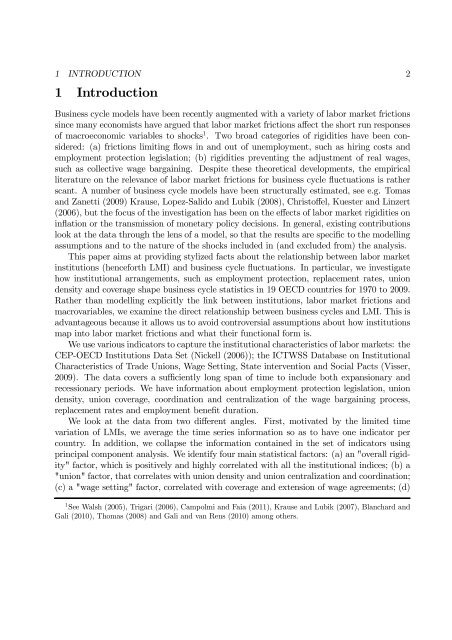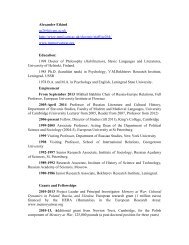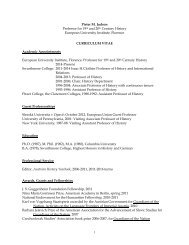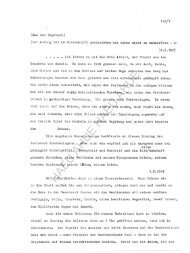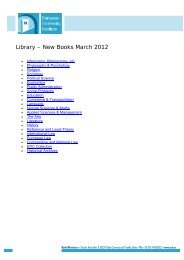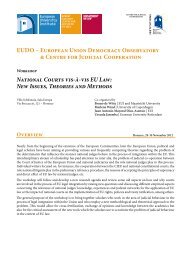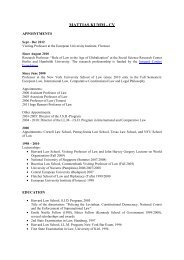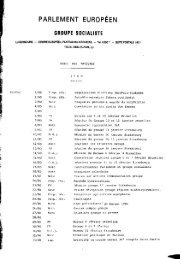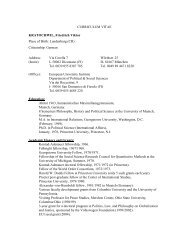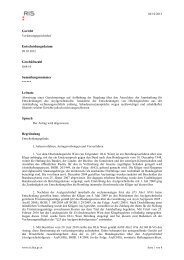Do labor market institutions matter for business cycles?∗ - European ...
Do labor market institutions matter for business cycles?∗ - European ...
Do labor market institutions matter for business cycles?∗ - European ...
You also want an ePaper? Increase the reach of your titles
YUMPU automatically turns print PDFs into web optimized ePapers that Google loves.
1 INTRODUCTION 2<br />
1 Introduction<br />
Business cycle models have been recently augmented with a variety of <strong>labor</strong> <strong>market</strong> frictions<br />
since many economists have argued that <strong>labor</strong> <strong>market</strong> frictions affect the short run responses<br />
of macroeconomic variables to shocks 1 . Two broad categories of rigidities have been considered:<br />
(a) frictions limiting flows in and out of unemployment, such as hiring costs and<br />
employment protection legislation; (b) rigidities preventing the adjustment of real wages,<br />
such as collective wage bargaining. Despite these theoretical developments, the empirical<br />
literature on the relevance of <strong>labor</strong> <strong>market</strong> frictions <strong>for</strong> <strong>business</strong> cycle fluctuations is rather<br />
scant. A number of <strong>business</strong> cycle models have been structurally estimated, see e.g. Tomas<br />
and Zanetti (2009) Krause, Lopez-Salido and Lubik (2008), Christoffel, Kuester and Linzert<br />
(2006), but the focus of the investigation has been on the effects of <strong>labor</strong> <strong>market</strong> rigidities on<br />
inflation or the transmission of monetary policy decisions. In general, existing contributions<br />
look at the data through the lens of a model, so that the results are specific to the modelling<br />
assumptions and to the nature of the shocks included in (and excluded from) the analysis.<br />
This paper aims at providing stylized facts about the relationship between <strong>labor</strong> <strong>market</strong><br />
<strong>institutions</strong> (hence<strong>for</strong>th LMI) and <strong>business</strong> cycle fluctuations. In particular, we investigate<br />
how institutional arrangements, such as employment protection, replacement rates, union<br />
density and coverage shape <strong>business</strong> cycle statistics in 19 OECD countries <strong>for</strong> 1970 to 2009.<br />
Rather than modelling explicitly the link between <strong>institutions</strong>, <strong>labor</strong> <strong>market</strong> frictions and<br />
macrovariables, we examine the direct relationship between <strong>business</strong> <strong>cycles</strong> and LMI. This is<br />
advantageous because it allows us to avoid controversial assumptions about how <strong>institutions</strong><br />
map into <strong>labor</strong> <strong>market</strong> frictions and what their functional <strong>for</strong>m is.<br />
We use various indicators to capture the institutional characteristics of <strong>labor</strong> <strong>market</strong>s: the<br />
CEP-OECD Institutions Data Set (Nickell (2006)); the ICTWSS Database on Institutional<br />
Characteristics of Trade Unions, Wage Setting, State intervention and Social Pacts (Visser,<br />
2009). The data covers a sufficiently long span of time to include both expansionary and<br />
recessionary periods. We have in<strong>for</strong>mation about employment protection legislation, union<br />
density, union coverage, coordination and centralization of the wage bargaining process,<br />
replacement rates and employment benefit duration.<br />
We look at the data from two different angles. First, motivated by the limited time<br />
variation of LMIs, we average the time series in<strong>for</strong>mation so as to have one indicator per<br />
country. In addition, we collapse the in<strong>for</strong>mation contained in the set of indicators using<br />
principal component analysis. We identify four main statistical factors: (a) an "overall rigidity"<br />
factor, which is positively and highly correlated with all the institutional indices; (b) a<br />
"union" factor, that correlates with union density and union centralization and coordination;<br />
(c) a "wage setting" factor, correlated with coverage and extension of wage agreements; (d)<br />
1 See Walsh (2005), Trigari (2006), Campolmi and Faia (2011), Krause and Lubik (2007), Blanchard and<br />
Gali (2010), Thomas (2008) and Gali and van Rens (2010) among others.


